Volume: 21 Issue: 11 November 2023
FULL TEXT
Objectives: This study aimed to analyze research projects on lung transplant funded by the National Natural Science Foundation of China from 1986 to 2022 and to provide a scientific reference for lung transplant research.
Materials and Methods: We identified research hotspots and frontiers in the field of lung transplant research using CiteSpace visualization.
Results: From 1986 to 2022, the National Natural Science Foundation of China funded 93 projects related to lung transplant, with an average of 2.51 projects and ¥0.94 million annually. The National Natural Science Foundation of China funded 30 institutions across 20 provinces, with general and youth science foundation projects comprising 45.16% and 41.93% of the total projects, respectively. The main categories of disciplines included H0113 respiratory intervention, tracheal reconstruction, and lung transplantation; H1105 organ transplantation and transplant immunization; and H0109 acute lung injury and acute respiratory distress syndrome. The research hotspots mainly included ischemia-reperfusion injury, gene regulation, obliterative bronchiolitis, rejection reaction, T cells, and stem cells. The 6 main research clusters were ischemia-reperfusion injury, immune tolerance, obliterative bronchiolitis, stem cells, pulmonary fibrosis, and rejection reaction. The main key word bursts in the past 5 years were “vein endothelial” and “ex vivo lung perfusion.”
Conclusions: In the past 37 years, National Natural Science Foundation of China-funded projects have significantly advanced the clinical application and basic research of lung transplantation. However, compared with developed countries and other solid-organ transplantations, several problems still require attention and improvements in lung transplant research in China.
Key words : Clinical research, Fundamental research, Research frontiers, Research hotspots
Introduction
Lung transplantation is the only effective treatment for end-stage lung disease.1 Over 70?000 lung transplants have been performed worldwide since 1990.2 The data analysis report on thoracic organ transplant cohorts by the International Society for Heart and Lung Transplantation focuses on a topic each year, such as donor and recipient age, retrans-plantation, transplant indications, and graft ischemia time.3-7 Recently, marginal donor lung, ex vivo lung perfusion (EVLP), and extracorporeal membrane oxygenation have become the focus of lung transplan-tation. Nevertheless, survival rates after lung trans-plant are still lower than rates for other solid-organ transplants. Problems, such as donor shortage, donor lung maintenance, primary graft dysfunction, and chronic graft dysfunction, still hinder the development of lung transplantation. Therefore, studies on lung transplant and its basic medicine are important.
The National Natural Science Foundation of China (NSFC) was established in 1986. It is one of the most important and most high-level research funding institutions in China and has greatly promoted scientific research, innovation, and discipline. Analysis of projects funded by NSFC can reflect the nation’s support for research and identify research frontiers and hotspots in this field.8 This study aimed to analyze NSFC-funded projects on lung transplantation from 1986 to 2022, provide insights into scientific research trends, guide the direction of research, and assist lung transplant professionals globally and in China.
Materials and Methods
Data sources
Using the NSFC network information system, we used the key word “lung transplantation” as the search strategy to identify funded projects from 1986 to 2022. Lung transplant experts were invited to review all key words, abstracts, or concluding reports, and the funding projects that met the study criteria were selected. No ethical approval was required, as there were no human participants in this study.
Quality control and statistical methods
We gathered data on various parameters, such as project leaders, supporting units, project names, key words, funding type, project year and duration, and funding amount. We entered parameters into an EXCEL 2019 form to establish a database. To ensure quality control, 2 researchers independently collected and entered the data, cross-checking until consistency was achieved. We used CiteSpace software (6.2. R2) to perform research frontier and hotspot analysis.9
Results
Number and amount of funded projects
Between 1986 and 2022, NSFC funded a total of 93 projects in the field of lung transplantation, with funding for an average of 2.51 projects annually. The cumulative funding amounted to ¥34.60 million, averaging ¥0.94 million annually. Project numbers exhibited an initial increase, peaking in 2016 with 11 funded projects, whereas, prior to 2003, there were almost no projects, except for 1 in 1993. However, project numbers gradually declined after 2016, with only 2 funded by 2022. A similar trend was observed from the yearly analysis of the funding amount, reaching a peak of ¥4.35 million in 2013. Subsequently, the funding amount gradually decreased to ¥0.60 million in 2022 (Figure 1).
Funded project institutions and geographical distribution
From 1986 to 2022, the NSFC funded 30 institutions across 20 provinces in the field of lung transplantation. Regarding the geographical distribution of funding, Shanghai and Hubei emerged as the top 2 funded regions. Both provinces had over 18 projects and received over ¥5 million in funding. Shanghai ranked first with 33 funded projects, accounting for over one-third of the total number of funded projects and receiving over one-third of the total funds. Overall, the regional distribution of project funding was unbalanced (Table 1).
The top 7 funded institutions in terms of funding distribution were Tongji University, Huazhong University of Science and Technology, Harbin Medical University, Shanghai Jiao Tong University, Capital Medical University, and Fudan University. Tongji University and Huazhong University of Science and Technology ranked among the top 2 regarding project quantity and funding amount (Table 2). Tongji University ranked first with 21 funded projects and ¥8.32 million in funding, surpassing other institutions. This accounted for 22.58% of the total number of projects and 24.05% of the total funding, highlighting the institution’s strong research capabilities in the field of lung transplantation.
Types of funded projects
The NSFC funding categories include key projects, general projects, youth science foundation projects, regional science foundation projects, major research plan projects, National Outstanding Youth Science Foundation projects, and special fund projects. Data analysis revealed large differences in the number and funding amounts among these categories (Table 3). General and youth science foundation projects accounted for 45.16% and 41.93% of the total number of projects, respectively. However, the average funding amounts were ¥0.49 million and ¥0.22 million, respectively. Major research plans and key projects had smaller numbers but relatively high average funding, with individual averages of ¥0.60 and ¥1.75 million, respectively.
Disciplines of funded project
In the field of lung transplantation, NSFC funding is categorized into 3 main disciplines: H0113 respiratory intervention, tracheal reconstruction, and lung transplantation; H1105 organ transplantation and transplantation immunization; and H0109 acute lung injury and acute respiratory distress syndrome. Among these, the category of H0113 respiratory intervention, tracheal reconstruction, and lung transplantation received funding for 47 projects, accounting for 50.54% of the total projects. The average funding amount for H0109 acute lung injury and acute respiratory distress syndrome was the highest, reaching ¥0.45 million (Table 4).
Analysis of research hotspots and frontiers
Key word co-occurrence analysis. We used CiteSpace to construct a key word co-occurrence network graph. The comprehensive high-frequency and high-centrality key word distribution and the co-occurrence relationship graph are shown in Table 5 and Figure 2. The research hotspots of lung transplantation inclu-ded ischemia-reperfusion injury, gene regulation, obliterative bronchiolitis, rejection reaction, T cell, and stem cell.
Key word clustering analysis. Using CiteSpace, we performed key word clustering for lung transplant research projects based on a co-occurrence network. Figure 3 shows the clustering results, with Q and S values of 0.5597 and 0.8857, respectively, indicating significant clustering and strong credibility. The 6 main research clusters identified were ischemia-reperfusion injury, immune tolerance, obliterative bronchiolitis, stem cell, pulmonary fibrosis, and rejection reaction.
Research frontier analysis
We used the CiteSpace key word burst method to conduct cutting-edge research analysis using a 2-year time span. Figure 4 shows the top 12 key words according to the intensity of the key word burst. By combing the time distribution of these key words, we identified the research frontiers of lung transplant research in each period. Before 2004, there were almost no key word bursts. From 2004 to 2010, the main key word bursts were ischemia-reperfusion injury, T cell, obliterative bronchiolitis, gene regulation, and donor lung preservation. From 2010 to 2018, the main key word bursts were immune tolerance, stem cell, pulmonary fibrosis, and lung injury. The main key word bursts in the past 5 years were “vein endothelial” and “ex vivo lung perfusion.”
Discussion
Analysis of overall funding quantity and amount
This study revealed that NSFC funded 262 projects related to lung transplantation, averaging 2.51 projects and ¥0.94 million annually from 1986 to 2022. Generally, lung transplant projects increased from 2006 to 2016, promoting the rapid development of lung transplant research. However, the overall funding and growth rate have decreased since 2016, with only 2 projects funded in 2022, which does not align with the field’s development speed. This indicates a discrepancy between the advancement of scientific research and clinical technology in lung transplant. Furthermore, lung transplant research lags behind that of other solid-organ transplant research, such as liver, kidney, and heart.
This study revealed that the major projects funded were general and youth science foundation projects. Only 1 key project and 1 major research plan project were funded. Innovative research group projects, National Science Fund for Distinguished Young Scholars, and other high-level funding were lacking. This indicates a scarcity of high-level research achievements with international prominence in China and a limited number of research experts and teams at the forefront of the field. Therefore, enhancing the scientific research level in the field of lung transplant in China is essential for enhancing the development of lung transplant medical technology, which will be beneficial to patients who require lung transplant.
Analysis of the regional distribution of funded projects
Over the span of 37 years, NSFC has funded lung transplant projects in 20 provinces. However, the top 2 regions, Shanghai and Hubei, accounted for over half of the funded projects, with Shanghai accounting for over one-third, reflecting a significant regional imbalance. Moreover, only 30 institutions nationwide received funded projects, with Tongji University alone securing 22.58% of the funded projects. Additionally, the top 7 institutions are traditional medical schools, including 3 in Shanghai and 2 in Hubei. This indicates a significant disparity in competitive strength among institutions in the field of lung transplantation.
The distribution of project-funded institutions showed a clustering trend, mainly located in the eastern coastal and central developed provinces, with fewer institutions in the western region. This disparity is mainly attributed to the larger population base, better scientific research foundation, and greater economic strength of the eastern region compared with the western region. However, this phenomenon hampers the application and advancement of lung transplant medical technology, potentially leading to patient outflow from the western region and increasing the economic burden for such patients. Simultaneously, it hinders the development of medical institutions in the western regions. To address this situation, urgent measures should be taken to improve medical and scientific research in lung transplant in western China. This can be achieved through collaborative efforts between provinces, remote consultations, and support from counterpart institutions. Furthermore, because organ transplant qualification requires approval from the National Health Commission of the People’s Republic of China, providing preferential treatment to the western region is recommended when the basic requirements for organ transplantation are met. This would encourage the implementation of lung transplant and other solid-organ transplant procedures in the western region, enabling patients to receive treatment locally, benefiting lung transplant patients, and reducing economic burden to patients.
Analysis of research hotspots
We identified 6 main research clusters: ischemia-reperfusion injury, immune tolerance, obliterative bronchiolitis, stem cell, pulmonary fibrosis, and rejection reaction.
Ischemia-reperfusion injury is an important cause of respiratory failure after lung transplant.10 Effective management of ischemia-reperfusion injury is key to the success of lung transplant. Finding effective measures to prevent and treat lung ischemia-reperfusion injury is of great clinical significance to increase the success rate of lung transplant and the long-term survival rate after transplant. The NSFC-funded research on ischemia-reperfusion injury mainly focuses on inhibiting, alleviating, and regulating this injury in cases of lung transplant. Examples include “IRF-8/IFN-γ study on the effect of selective autophagy and its mechanism in pulmonary ischemia-reperfusion injury,” “Effect and mechanism of maresin1 on inhibiting ferroptosis and alleviating early lung ischemia-reperfusion injury after lung transplantation,” and “Effect and mechanism of extracorporeal lung perfusion combined with drug intervention on ischemia-reperfusion injury after lung transplantation in rats.”
To avoid transplant rejection, recipients must undergo lifelong administration of immunosup-pressive drugs. Although they are effective in ensuring short-term survival, nonspecific reactions and other adverse effects of immunosuppressives have significant negative effects on the long-term survival of the graft. Therefore, establishing and maintaining donor antigen-specific immune tolerance may be fundamental to solving organ transplant rejection.11 The NSFC-funded research on immune tolerance includes “Effect and mechanism of sirolimus combined with sTNFRI IgGFc electrogenetically modified dendritic cells on immune tolerance induced by lung transplantation in mice” and “Experimental study on induction of immune tolerance in lung transplantation rats.”
Obliterative bronchiolitis is the main factor affecting long-term survival after lung transplant.12 Its mechanism involves tissue fibrosis and immune rejection. Presently, there is no effective treatment plan. The NSFC-funded research on bronchiolitis obliterans includes “Mechanism of blocking Adam10/Notch1 signaling pathway of myeloid macrophages to slow down bronchiolitis obliterans associated with lung transplantation,” “Role and mechanism of autophagy associated epithelial-mesenchymal transformation regulated by farnesyl diphosphate synthase in bronchiolitis obliterans,” and “Cellular and molecular regulation mechanism and intervention of bronchiolitis obliterans after IL-17 mediated lung transplantation.”
Enhancing the “quality” and “quantity” of bone marrow mesenchymal stem cells is crucial for effectively treating lung ischemia-reperfusion injury, and recent advancements have shown promising progress in this regard.13 The NSFC-funded research on stem cells includes “Experimental study on the treatment of lung ischemia reperfusion injury with HGF modified mesenchymal stem cell transplan-tation based on ischemic post-adaptation” and “Study on the specific differentiation and regulation mechanism of human adult lung stem cells in the Chung-guyok of acellular lung scaffold.”
Pulmonary fibrosis is a respiratory disease that forms scars in the lung tissue, causing serious respiratory problems in patients. Currently, lung transplant is the only effective treatment for pulmonary fibrosis.14 Research on the etiology of pulmonary fibrosis and antifibrosis drugs has been challenging worldwide. The NSFC-funded research on pulmonary fibrosis includes “Mechanism of AQP5 regulating the imbalance of immunogenic and neurogenic CGRP to induce pulmonary fibrosis,” “Effects of fine particles of air pollution on idiopathic pulmonary fibrosis and its molecular mechanism,” and “Collagen receptor DDR2 synergizes with TGF-β: study on the molecular mechanism of the pathway promoting pulmonary fibrosis.”
Transplant rejection reaction is an important problem in organ transplant and remains a constant focus in the context of lung transplant. The NSFC-funded research on rejection reaction includes “Effect and its mechanism research of glutamate transaminase 1 (GOT1) - shRNA on acute rejection of lung transplantation in rats,” “Role and mechanism of CD8 memory T cell in immune rejection of lung transplantation,” and “Tim-3/galectin-9 signaling pathway mediates acute rejection after lung transplantation and its mechanism.”
Analysis of research frontiers
This study revealed that the main key word bursts from 2010 to 2018 were immune tolerance, stem cell, pulmonary fibrosis, and lung injury. However, in the past 5 years, the main key word bursts are now “vein endothelial” and “ex vivo lung perfusion” This indicates a change in the lung transplant research focus in China. Previously, the emphasis was on immune rejection and lung injury after lung transplant, and efforts were made to suppress and improve these aspects. Recent research has increasingly focused on pre-lung transplant, such as donor lung preservation, maintenance, and tissue research, to address the root cause by eliminating signals that induce inflammation and injury.
The study titled “Regulation and mechanism of vein endothelial on inflammation and injury during the preservation of donor lung in lung transplantation” conducted research at the molecular, cellular, whole animal model, and clinical sample levels and aimed to clarify the regulatory role of vein endothelial cells on inflammation and injury during cold ischemia preservation of donor lungs, providing a theoretical basis for the clinical development of strategies for preserving donor lungs, increasing the availability of donor lungs, and thus improving the long-term survival of grafts and recipients after lung transplant. The recent development of EVLP technology has expanded the utilization rate of donor lungs; however, its mechanism of alleviating reperfusion injury after transplant remains unclear. The study “Effect and mechanism of extracorporeal lung perfusion (EVLP) combined with drug inter-vention on ischemia-reperfusion injury after lung transplantation in rats” reported that combining EVLP with pharmacological interventions can improve donor lung compliance, peak airway pressure, pulmonary vascular resistance, and oxygenation capacity.
In general, China still has some ground to cover regarding lung transplant research. For example, few studies exist in China on the application of 3-dimensional printing technology in lung and xenogeneic lung transplant.15-17 For many years, the world has used data registration queues to improve the availability of donor lungs with the maintenance of donor information, for the improvement of surgical methods, and for optimization of organ allocation strategies. There is increasing evidence for the clinical application of EVLP in lung transplant centers in Europe and the United States.18
With the growing aging population, the policies of organ transplant in various countries have been modified to remove previous restrictions on age, and the prognosis of elderly lung transplant recipients is now being investigated and analyzed.19 However, the lung transplant centers in the United States have been more active in promoting the development of infant lung transplant technology and actively exploring perioperative extracorporeal lung assistance technology.20 At present, research is lacking in the field of basic research and drug therapy related to lung transplant in China, especially with regard to microecology, organ function, and immune regulation, which have received more attention in other countries in recent years. Compared with studies in China, foreign studies have found that lung transplant recipients tend to have chronic graft failure and pulmonary colonization flora after lung transplant.21
The primary limitation and delimitation of our study are that the scope was limited to only NSFC-funded projects in the field of lung transplant research in China. This was primarily because of limited funding provided by other organizations for lung transplant research in China.
Conclusions
We identified the NSFC-funded projects in the field of lung transplant research from 1986 to 2022 and described their distribution characteristics in terms of number, funding amount, and project category. CiteSpace co-occurrence analysis, cluster analysis, and other visual means were used to show research hotspots and frontiers. Overall, NSFC-funded projects have significantly contributed to the advancement of clinical application and basic research in lung transplantation. However, compared with other developed countries and research for other solid-organ transplants, there remain several noteworthy issues and areas of improvement in lung transplant research in China.
References:
- Li JH, Xu X, Wang YF, et al. Chinese expert consensus on organ protection of transplantation (2022 edition). Hepatobiliary Pancreat Dis Int. 2022;21(6):516-526. doi:10.1016/j.hbpd.2022.10.010
CrossRef - PubMed - Rucker AJ, Nellis JR, Klapper JA, Hartwig MG. Lung retransplantation in the modern era. J Thorac Dis. 2021;13(11):6587-6593. doi:10.21037/jtd-2021-25
CrossRef - PubMed - Chambers DC, Yusen RD, Cherikh WS, et al. The Registry of the International Society for Heart and Lung Transplantation: Thirty-fourth Adult Lung And Heart-Lung Transplantation Report-2017; focus theme: allograft ischemic time. J Heart Lung Transplant. 2017;36(10):1047-1059. doi:10.1016/j.healun.2017.07.016
CrossRef: https://doi.org/10.1016/j.healun.2017.07.016
PubMed - Chambers DC, Cherikh WS, Goldfarb SB, et al. The International Thoracic Organ Transplant Registry of the International Society for Heart and Lung Transplantation: Thirty-fifth adult lung and heart-lung transplant report-2018; focus theme: multiorgan transplantation. J Heart Lung Transplant. 2018;37(10):1169-1183. doi:10.1016/j.healun.2018.07.020
CrossRef - PubMed - Chambers DC, Cherikh WS, Harhay MO, et al. The International Thoracic Organ Transplant Registry of the International Society for Heart and Lung Transplantation: Thirty-sixth adult lung and heart-lung transplantation Report-2019; focus theme: donor and recipient size match. J Heart Lung Transplant. 2019;38(10):1042-1055. doi:10.1016/j.healun.2019.08.001
CrossRef - PubMed - Chambers DC, Perch M, Zuckermann A, et al. The International Thoracic Organ Transplant Registry of the International Society for Heart and Lung Transplantation: Thirty-eighth adult lung transplantation report - 2021; focus on recipient characteristics. J Heart Lung Transplant. 2021;40(10):1060-1072. doi:10.1016/j.healun.2021.07.021
CrossRef - PubMed - Chambers DC, Zuckermann A, Cherikh WS, et al. The International Thoracic Organ Transplant Registry of the International Society for Heart and Lung Transplantation: 37th adult lung transplantation report - 2020; focus on deceased donor characteristics. J Heart Lung Transplant. 2020;39(10):1016-1027. doi:10.1016/j.healun.2020.07.009
CrossRef - PubMed - Yu R, Zhu MJ, Wang XL, Zhao QF, Wang JR. Analysis of the National Natural Science Foundation of China (NSFC) for cardiovascular diseases related projects in integrated traditional Chinese and western medicine from 2000 to 2019. Chinese J Integr Med Cardiocerebrovasc Dis. 2023;21:248-252.
CrossRef - PubMed - Chen C. Science mapping: a systematic review of the literature. J Data Inf Sci. 2017;2(2):1-40. doi:10.1515/jdis-2017-0006
CrossRef - PubMed - Shah RJ, Diamond JM. Primary graft dysfunction (PGD) following lung transplantation. Semin Respir Crit Care Med. 2018;39(2):148-154. doi:10.1055/s-0037-1615797
CrossRef - PubMed - 2017 American Transplant Congress Abstracts. Am J Transplant. 2017;17 Suppl 3:5-815. doi:10.1111/ajt.14304
CrossRef - PubMed - Yusen RD, Edwards LB, Dipchand AI, et al. The registry of the International Society for Heart and Lung Transplantation: thirty-third adult lung and heart–lung transplant report—2016; focus theme: primary diagnostic indications for transplant. The Journal of Heart and Lung Transplantation. 2016;35(10):1170-1184.
CrossRef - PubMed - Rosca AM, Tutuianu R, Titorencu ID. Mesenchymal stromal cells derived exosomes as tools for chronic wound healing therapy. Rom J Morphol Embryol. 2018;59(3):655-662.
CrossRef - PubMed - Tzilas V, Tzouvelekis A, Ryu JH, Bouros D. 2022 update on clinical practice guidelines for idiopathic pulmonary fibrosis and progressive pulmonary fibrosis. Lancet Respir Med. 2022;10(8):729-731. doi:10.1016/S2213-2600(22)00223-5
CrossRef - PubMed - Dabaghi M, Rochow N, Saraei N, et al. A pumpless microfluidic neonatal lung assist device for support of preterm neonates in respiratory distress. Adv Sci (Weinh). 2020;7(21):2001860. doi:10.1002/advs.202001860
CrossRef - PubMed - Kirk AD. When pigs fly. Am J Transplant. 2022;22(4):1007-1008. doi:10.1111/ajt.16963
CrossRef - PubMed - Burdorf L, Laird CT, Harris DG, et al. Pig-to-baboon lung xenotransplantation: Extended survival with targeted genetic modifications and pharmacologic treatments. Am J Transplant. 2022;22(1):28-45. doi:10.1111/ajt.16809
CrossRef - PubMed - Chen Y, Wei D, Wang Z, et al. Experimental study on the role of IL-10 in improving donor lung function after ex vivo lung perfusion in rats of cardiac death. Organ Transplant. 2021:12(4) 421-427. doi:10.3969/j.issn.1674-7445.2021.04.008
CrossRef - PubMed - Costello JP, Carvajal HG, Abarbanell AM, Eghtesady P, Nath DS. Surgical considerations in infant lung transplantation: challenges and opportunities. Am J Transplant. 2021;21(1):15-20. doi:10.1111/ajt.16282
CrossRef - PubMed - Schweiger T, Hoetzenecker K. Is chronological age still a hard selection criterion for lung transplantation? J Heart Lung Transplant. 2021;40(2):99-100. doi:10.1016/j.healun.2020.11.011
CrossRef - PubMed - Combs MP, Wheeler DS, Luth JE, et al. Lung microbiota predict chronic rejection in healthy lung transplant recipients: a prospective cohort study. Lancet Respir Med. 2021;9(6):601-612. doi:10.1016/S2213-2600(20)30405-7
CrossRef - PubMed

Volume : 21
Issue : 11
Pages : 893 - 900
DOI : 10.6002/ect.2023.0220
From the 1Department of Medical Administration, Fujian Medical University Union Hospital, Fuzhou City; the 2School of Public Administration & Law, Fujian Agriculture and Forestry University, Fuzhou City; and the 3Department of Education Administration, Fujian Medical University Union Hospital, Fuzhou City, Fujian Province, China
Acknowledgements: This work was supported by the Startup Fund for Scientific Research (Fujian Medical University) (2021QH1053). The funding source had no role in the study design; the collection, analysis, or interpretation of the data; the writing of the report; or in the decision to submit the article for publication. The authors have no declarations of potential conflicts of interest. We thank those who have helped us throughout the research process and writing of this paper. Our sincere gratitude also goes to our professors and teachers who have greatly helped us in our study and our lives. Finally, we thank our friends and families who have given us much needed encouragement and financial support.* X. Xie, Z. Zhao, and Q Wu contributed equally to this work.
Corresponding author: Qinde Wu, Department of Education Administration, Fujian Medical University Union Hospital, 29 Xinquan Road, Fuzhou City, Fujian Province, China
Phone: +86 13365917369
E-mail: qdwu88@126.com
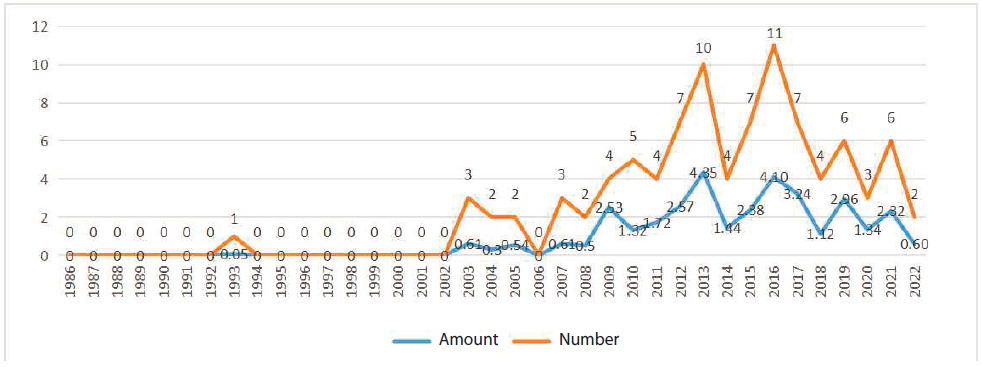
Figure 1. Amount of Funding and Number of Studies Funded by the National Natural Science Foundation of China in the Field of Lung Transplantation From 1986 to 2022
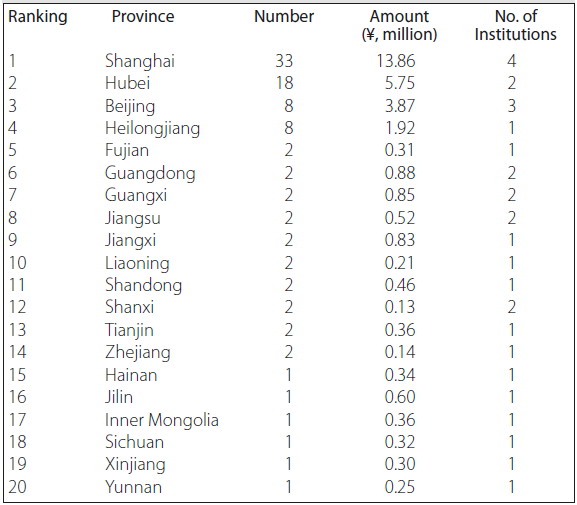
Table 1. Regional Ranking and Distribution of Funded Projects
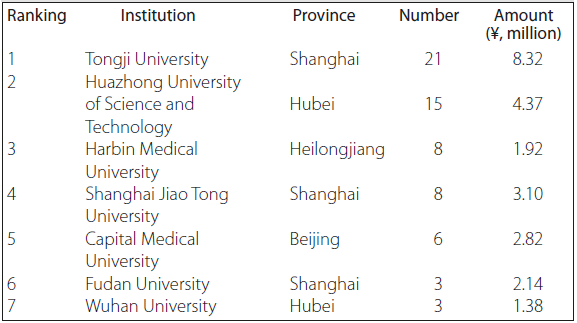
Table 2. Ranking of Institutions That Received Funding
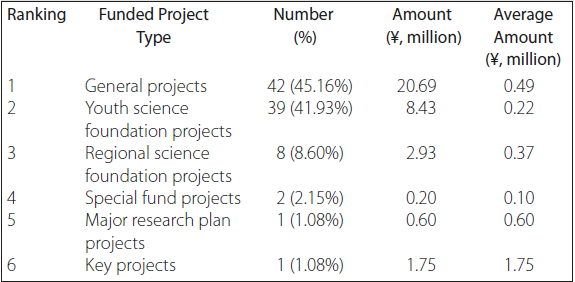
Table 3. Categories of Funded Projects

Table 4. Disciplines of Funded Projects
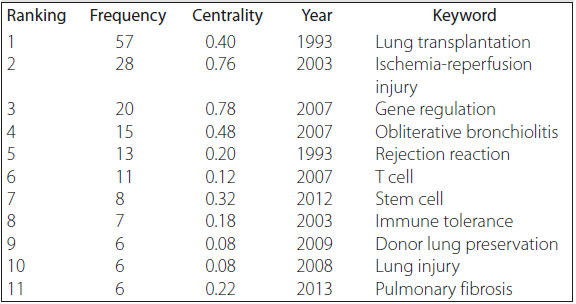
Table 5. Top 11 Key Words in the Frequency Ranking
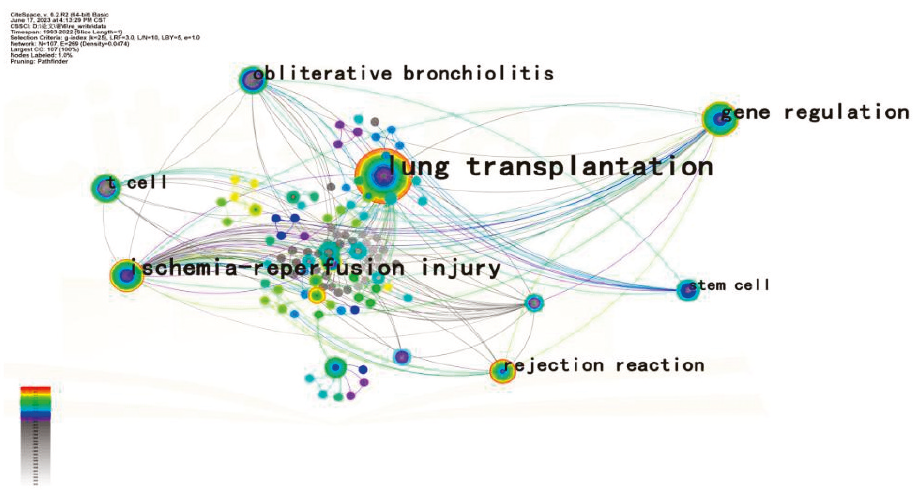
Figure 2. Key Word Co-occurrence Map
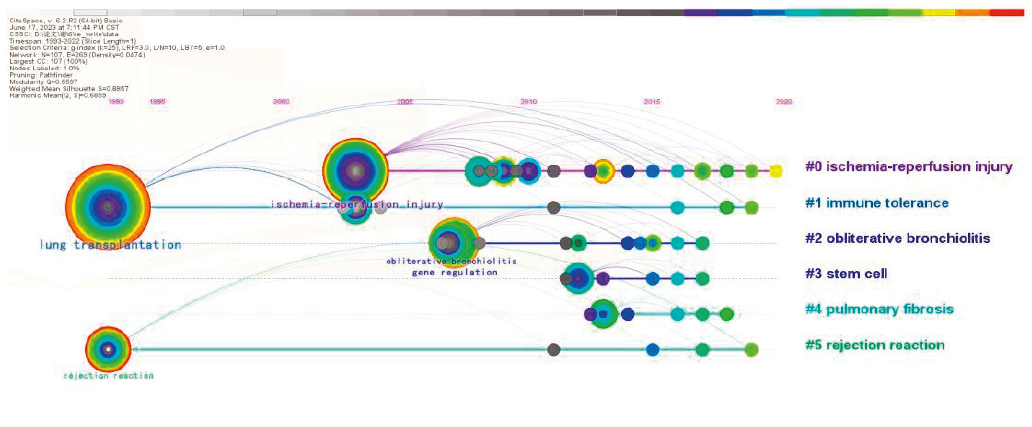
Figure 3. Key Word Clustering Timeline
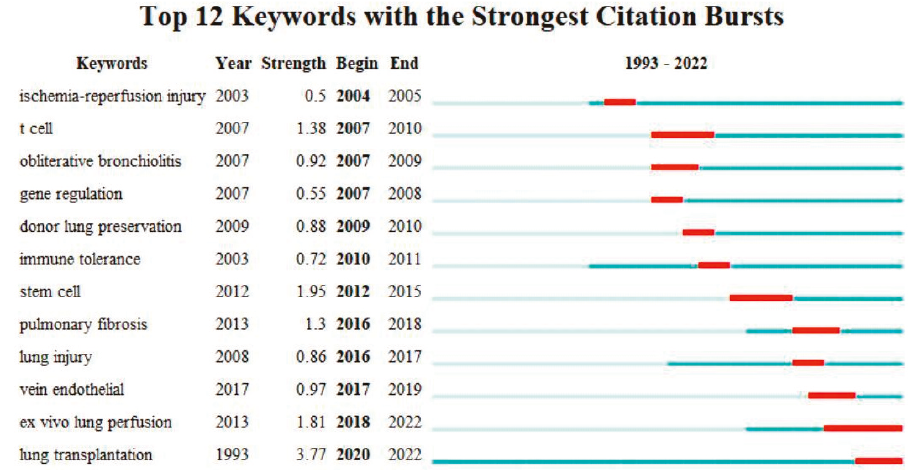
Figure 4. Top 12 Key Word Bursts